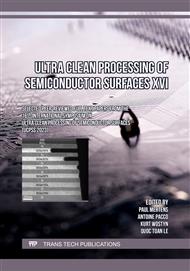p.253
p.258
p.263
p.268
p.275
p.280
p.289
p.296
p.302
Pinpoint Particle Removal for EUV Pellicle Productivity Enhancement
Abstract:
The EUV lithography process is increasingly employed in the advanced semiconductor process, and high-NA EUV equipment is being developed for high-volume manufacturing. Therefore, particle contamination control for EUV masks is a key success factor for the yield increase of the EUV lithography process in the future and for this, the needs of EUV pellicle will increase. Although materials for the EUV pellicle membrane are still under development, unlike ArF pellicles, its fabrication is complicated and difficult, resulting in low production yield and high production costs. To reduce EUV pellicle operating costs, it is possible to consider ways to reduce production costs by enhancing the yield of EUV pellicle or reusing particle contaminated EUV pellicle by particle removal. Both methods require damage-free particle removal technology of EUV pellicle. Pinpoint particle removal technology, a cleaning technology that satisfies these requirements, was developed, and particles bigger than 5 μm could be removed in a cleanroom environment without damaging fragile EUV pellicle. The possibility of the damage-free EUV pellicle cleaning process was verified through the process window evaluation of Pinpoint cleaning technology.
Info:
Periodical:
Pages:
275-279
Citation:
Online since:
August 2023
Authors:
Keywords:
Price:
Сopyright:
© 2023 Trans Tech Publications Ltd. All Rights Reserved
Share:
Citation:


